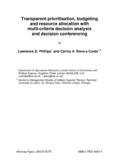Transcription of Understanding the Local Impact of New Residential ...
1 Understanding the Local Impact of New Residential development : a pilot study Final Report April 2015 Christine Whitehead and Emma Sagor with Ann Edge and Bruce Walker 1 1. Introduction1 The objective of the project is to make a contribution to Understanding the Impact of new housing development on the immediately surrounding area and population. In particular the project looks to see: what is the evidence about whether house prices in the surrounding area always fall; whether there are patterns in price development in these areas which appear to be associated with different types of development ; and whether other factors affecting prices can be identified. The initial response of many people to the possibility of new Residential development nearby is that it will reduce their wellbeing, notably with respect to access to Local services, their own immediate environment and simply because of the Impact of increased population in the area.
2 Partly this is about expectations households usually expect to be able to keep their views, for example, or they may expect that more development will result in lower quality services. More generally households can be resistant to change and uncertainty concerning their neighbourhood and neighbours. Economically, residents may be worried about whether the market might respond to development by reducing the prices of existing dwellings as a result of increased supply, or whether demand might decrease as a result of the degradation of Local attributes. These issues are core to the longer-term acceptability of new development . This project, sponsored by Barratt and the NHBC Foundation, aims to address these issues by looking in detail at a small number of sites to help identify the factors which determine whether development will have a positive, negative or neutral effect on the locality and therefore on house prices.
3 Important in the shorter term is the extent of disruption generated by the development and into the longer term the Impact it might have on the nature of the area and the community as well as directly on house prices. 1 We are grateful to Philip Barnes, Neil Smith, Nancy Holman and Henry Overman for their constructive comments. 2 2. Understanding the question In order to provide a framework for Understanding how new development might affect prices and welfare in the surrounding area we start by looking at the role of the planning system in determining planning permissions; the economic Impact of increasing supply on Local markets and house prices; and evidence on household attitudes towards new house building and the development process. The role of the planning system The planning system in England essentially comprises the preparation of planning policies at national and Local spatial scales and the control of development through the determination of planning applications and enforcement.
4 Planning applications are assessed by the relevant planning authorities on the basis of conformity with the National Planning Policy Framework and Local development plans (DCLG, 2012). During the period of our study there was a significant streamlining of planning policy, which removed the regional planning policy tier and led to the winding up of regional development corporations, relevant for example to our case study in Thurrock. The development control aspect of the planning system assesses proposals against national and Local planning policies, examining each potential development in terms of its social, economic and environmental Impact within the legislative framework. In the context of Residential development , Local planning policies stipulate the amount of new housing needed in an area as well as the types of dwellings required and guidance as to where Residential development should occur (for more context, see Smith, 2015).
5 Those affected by a specific development have a right to comment and to have their concerns about the development s Impact taken into account. Importantly the issues that can be taken into account do not include the possibility that Local house prices may be adversely affected, although it is often argued that this possibility lies behind many of the objections which are put in terms of negative externalities (Sturzaker, 2011). The planner s role includes mitigating any potentially negative outcomes of a development as experienced by affected third parties, thus bridging any gap between the private value of the development , judged in terms of market values, and its broader social value. Potential impacts of new development The interim report of the Barker Review of Housing Supply (Barker, 2003) examined the difficulties facing the planning system in achieving a balance between economic, social and environmental objectives at the Local level.
6 In particular, the costs of new housing development are perceived and evaluated by Local households who are directly affected, whereas the potential benefits tend to be more diffuse and often not transparent. Opposition to new housing development is often seen as driven by this feeling that Local communities gain little benefit from new homes and that instead new Residential development creates negative impacts, including pressure on existing infrastructure and services, reduced environmental amenity, and slower Residential price rises (or perhaps price reductions) (Matthews, Bramley and Hastings, 2014: 58). Potential costs of new Residential development to established households include: 1. loss of amenity which not only reduces individual welfare but may also reduce property values; 2. pressure on Local services; 3. pressure on infrastructure, causing congestion, pollution, and road safety issues; 3 4.
7 Adverse consequences of ill-designed developments that fail to foster community these include social as well as economic and environmental costs, all of which can reduce property values; and most directly 5. additional supply may generate lower house prices reducing wellbeing among those already living in the neighbourhood. Potential benefits include: 1. the provision of more and better housing to accommodate additional households; 2. the possibility of increased property values if new development is well designed and complements existing housing; 3. the possibility that development brings in new infrastructure; 4. longer term improvements in affordability across the housing market; 5. additional spending and investment in Local shops and services 6. additional investment in the Local area arising from Section 106 or CIL payments from the developer. A big issue in this context, as we have already noted, is that the potential costs generally lie with households established in the area while many of the benefits go to new entrants into the locality or are spread more generally over the whole market.
8 In addition much of the rhetoric around national housing policy implies that a longer-term objective is to improve affordability by expanding supply and reducing house prices, thus fuelling the idea that new development could lower values in the surrounding area. Impact of development on Local house prices There are large numbers of studies that examine the effect of new housing supply on prices at national and regional levels, but there are very few that look at the effect on the Local area and particularly the immediate locality in anything but the most qualitative terms. The Impact of new development on Local house prices depends on supply and demand. On the supply side, the new development increases number of units of particular types of housing in the immediate area. Developers set the prices of their units to ensure that they are competitive within the existing housing market. They aim to undertake the development in a way and at a speed that generates the best possible return on capital employed (ROCE).
9 The scale of customer demand determines the pace of development and an expected norm is around to 1 sale per week per site. Customer demand can come from four main sources: those already looking for a home in the second hand market; newly forming households who are looking for a home. These households may currently be part of someone else s household ( they could be children currently living with parents), and they could come from the Local area or from a considerable distance away; the new housing improves the Local area by, for example, developing previously derelict sites, making the area safer and more desirable. This in turn increases the demand for the area and the number of people prepared to invest in that area. Again the demand may be from Local , established households or from further afield, but because of the improvements in the area, additional demand is created and prices may even rise, not only for the new development but for the surrounding area; the same arguments apply if Local infrastructure is improved and if high quality planning makes the Local environment more desirable.
10 4 At the same time there are direct costs to the community from development , notably with respect to the disruption experienced by the surrounding areas during the development process. This can be expected to have at least a short term negative effect on demand. Equally the process of development may slow the numbers of transactions as those living in the area may wait to sell until the future is more certain. However it should be stressed that house prices are about future as well as immediate benefits and costs, so if future price increases are expected these costs may simply be offset. Thus the economics suggests that other things being equal some reduction in house prices in the Local area can be expected, especially in the short term, as a result of new development , unless additional net benefits can be identified. The extent of such an effect could be expected to depend on the scale of the project in relation to the Local market both by adding to supply and by the interest it generates among potential buyers.
















